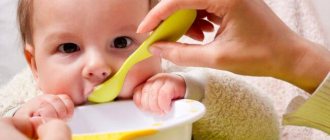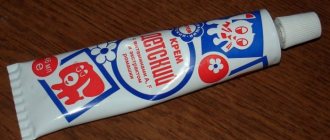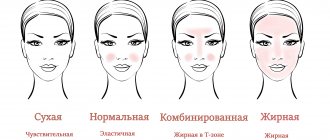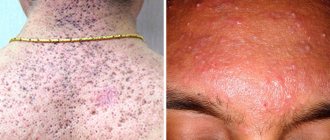Last update: 03/03/2021
Not so long ago, many dermatologists recommended refraining from frequent bathing if you were diagnosed with dermatitis. Today, doctors’ views on this problem are different: if you choose the right composition of water, cosmetics for bathing, and learn how to prepare decoctions and infusions for bathing, the number of water procedures can not be reduced. And yet, most people suffering from this disease are interested in the question: is it possible to swim with dermatitis in adults and children, and if so, what rules should be followed so as not to worsen the skin condition?
Is it possible to get dermatitis wet?
Contact with water on the affected areas of the skin usually causes an increase in the symptoms of the disease, and also provokes the spread of the lesion to other parts of the body. To figure out whether it is possible to swim with dermatitis in an adult and a child, you first need to determine which type of disease was diagnosed:
- With atopic dermatitis, bathing is not only possible, but necessary. The main requirement that must be observed is the use of not too hot and not too cold water.
- With seborrheic dermatitis, exacerbation can occur due to the use of hard chlorinated water. If you replace it with soft spring or thermal water, unpleasant symptoms may decrease.
- For contact dermatitis, you need to pay attention to the condition of the skin after contact with hygiene products - shower gel, soap. Perhaps they are the culprits for the appearance of symptoms of the disease.
- Is it possible to swim if you have allergic dermatitis? First you need to establish what exactly causes the allergic reaction. If you use herbal infusions for bathing, be sure to inform your doctor about this: some plants are precisely the triggers of allergic dermatitis.
Skin allergies: symptoms
Symptoms of skin allergies may appear immediately after contact with the allergen or after some time (from 10-20 minutes to 1-2 days).
The main signs of skin allergies can be considered:
- rash (can vary significantly with different types of skin allergies);
- redness and swelling of the skin;
- itching, scratching;
- dryness and flaking of the skin.
Scratching may lead to a bacterial or fungal infection, which further aggravates the course of the disease. All this creates severe physical and psychological discomfort, disrupting sleep and affecting ability to work.
Depending on the type of allergic dermatosis, certain signs of skin allergies may be particularly pronounced or, conversely, absent.
How should and can you wash yourself if you have dermatitis?
The main requirement for water procedures for dermatitis is the use of special personal hygiene products that are as gentle as possible and soft water. It is easier for residents of rural areas to comply with this requirement, since in most cases they have access to well or spring water.
But what about city residents? City residents can be advised to do the following: let the water sit before bathing, boil it, or purchase a special filter attachment that fits onto the shower head and traps chlorine particles.
As for the water temperature and the duration of hygiene procedures for dermatitis, the optimal solution would be to take a bath or shower at a temperature of 37-38 degrees for 5-10 minutes. It is better not to stay in the water for longer than the specified time. If you choose between a shower and a bath, then it is better to give preference to the shower. Avoid standard alkaline detergents (use ph neutral detergents).
It is prohibited to use hard washcloths, anti-cellulite mittens and skin scrubs. Remember: areas affected by dermatitis should not be rubbed, so you will have to avoid such products during and after bathing. The same applies to rubbing your skin after taking a bath or shower. Avoid vigorous movements when drying: simply blot wet skin with a soft towel, allowing the moisture to be absorbed into the fabric.
You should not swim in swimming pools, as the water in them is usually very hard and contains large amounts of chlorine.
How to distinguish heat rash in a child from allergies and other diseases
When a rash appears on the skin, the most difficult thing for parents is to distinguish prickly heat from other diseases: allergies, chicken pox, measles, etc.
First, you should examine the location of the rash. In the first case, the rashes are located in hard-to-reach places: in the area under the diaper, in the folds of the skin, in the hairline. In this case, the rash almost never appears on open areas of the skin that are well ventilated. But if the rash appears on the face, open parts of the arms and legs, most likely it is an allergy.
A simple home test will also help make a differential diagnosis. You just need to undress the baby and leave him without clothes or a diaper for several hours. If the rash appears as a result of prickly heat, during this time it will decrease and become paler. If it is an allergy, no changes will occur to it.
Additional symptoms will help distinguish the disease from measles, chickenpox and other viral pathologies. With infectious diseases, the temperature always rises, intoxication appears, and the rash quickly spreads throughout the body. In turn, the main symptom of prickly heat is just a rash.
Dermatitis and sea water
The closer the holiday period is, the more adults and children with skin problems are interested in the answer to the question: is it possible to swim in the sea with dermatitis - atopic, allergic and others?
Many people note that during a vacation spent at sea, the symptoms of dermatitis decrease. The skin becomes less dry, itching and redness disappear. The reason for this change lies in the healing composition of sea water, which has a beneficial effect on the affected areas of the epidermis.
In addition to directly swimming in the sea, you need to take into account the positive effect of the marine climate. Air saturated with microdroplets gently affects damaged skin without causing harm.
It is recommended to choose the velvet season as a time for vacation. During this period, the difference between water and air temperatures is not as large as in July-August. As for choosing a holiday destination, you should give preference to European coasts: a sharp change in climate, which is observed when flying from Russia to Asian countries, Turkey and Egypt, can negatively affect the condition of the skin.
Classification of the disease
There are four main types of miliaria, which differ in the nature of the rash, the duration of development and the severity of symptoms:
- Crystalline. It is accompanied by the development of a blistering rash, which most often appears on the head, behind the ears, and on the neck. Other localization of rashes is also possible. 2-3 days after the appearance, the blisters dry out and begin to peel off. Since irritation is not accompanied by inflammation or infection, the crystalline form is the simplest and most harmless.
- Red. A more complex type, in which sweat acts on the skin for a longer time and, accordingly, causes more severe irritation. A rash in the form of small inflamed tubercles provokes slight swelling and is accompanied by itching, burning, and discomfort. Lasts about two weeks.
- Miliaria alba, or vesiculopustulosis. With this type, blisters with a whitish or yellowish filling appear on the skin. When the bubble bursts, it leaves behind a light coating. The presence of color in the bubbly fluid indicates that the rash is accompanied by an infection, often staphylococcal.
- Deep. In most cases, prickly heat causes only superficial damage to the skin. With a deep form of pathology, the deep layers of the skin are affected. The disease is accompanied by blisters filled with light contents, which resolve or burst spontaneously.
Clinical researches
The conducted clinical study proves the high efficiency, safety and tolerability of products for daily skin care of children with mild and moderate forms of atopic dermatitis and during remission, accompanied by a decrease in the quality of life of patients. As a result of therapy, a decrease in the activity of the inflammatory process, a decrease in dryness, itching and flaking was noted.
Based on the results of the clinical study, the placement of information on the packaging “Recommended by the St. Petersburg Branch of the Union of Pediatricians of Russia” was agreed upon.
Sources:
- B.A. Shamov, I.G. Safiullina, A.B. Beshimova, T.B. Shamov, Differential diagnosis of atopic dermatitis, Journal of Practical Medicine, 2011
- Fokina R.A., Atopic dermatitis: stages of development of classification forms, Siberian Medical Journal, 2007
- A.N. Pampura, A.A. Chuslyaeva, Modern approaches to the treatment of atopic dermatitis in children
Photos of dermatitis
Photo album on the disease
Causes
Most often, parents who do not adhere to the basic rules of caring for the child turn to doctors with complaints about heat rash in their baby: they bathe him with soap every day, wrap him up excessively without taking into account the real ambient temperature. Children with skin allergies, diabetes mellitus, rickets, seborrheic dermatitis or frequent diarrhea are also at risk. Chubby, overweight and bottle-fed babies are especially at risk of developing rashes.
Among other reasons for the development of prickly heat in children are:
- non-compliance with normal temperature conditions;
- too hot, tight clothes or shoes that do not allow air to pass through and do not create natural ventilation;
- excessive use of skin cosmetics that disrupt the acid balance and cause increased sensitivity (soaps, baby creams, oils, etc.);
- rare change of diapers or their poor quality, lack of care;
- viral diseases that are accompanied by fever.
What treatment options are there?
There are many ways to treat the disease. The choice of method depends on the location of the disease:
- On the face . The most effective are pharmaceutical creams and ointments. Compresses on the face, especially on the eyelids, are applied with great care, since the skin of the face is very sensitive and delicate and can be damaged.
- On hands . Gels, ointments, folk remedies (lotions, compresses) are suitable.
- On the body . The affected areas are lubricated with ointments, gels and creams. However, in parallel with the use of these drugs, medicinal decoctions, herbal infusions and teas are ingested.
- On foot . To treat the affected areas, medicinal baths with the addition of herbal infusions are used, pharmaceutical creams and ointments, compresses and lotions are used.
It is recommended to take antihistamines. They will help eliminate redness and itching extremely quickly, no matter where in the body the disease appears. Such products are manufactured in the form of tablets and capsules.
Main causes of food allergies
8 foods cause 9 out of 10 food allergies.
In the first year of a child's life: cow's milk, soy milk and egg.
Older children: peanuts, tree nuts, fish, seafood and wheat.
Seafood includes shrimp, crab, lobster, clams, oysters and scallops.
Tree nuts include all nuts (such as almonds and cashews) except peanuts. Peanuts and tree nuts are the most common triggers for severe reactions.
Of children with a proven food allergy, 40% have severe reactions. The remaining 60% have a mild reaction.
Still have questions?
Get an online consultation from leading allergists in St. Petersburg!
A professional and experienced pediatrician will answer your questions.
Medical care for a child without leaving home at a convenient time.
sign up for a consultation
A Skype consultation lasts 45 minutes.
Folk remedies for safe bathing
Contact dermatitis differs from allergic dermatitis only in that it occurs as a result of direct contact with an allergen. Can I wash myself if I have contact dermatitis? If a person does not have a negative reaction to water, then the scheme for taking water procedures in this case will be the same as for allergic dermatitis.
Otherwise, you need to contact a dermatologist to take allergy tests to identify a reaction to substances contained in the local water (since they are the ones that cause skin rashes). Persons whose illness is aggravated by contact with tap water are advised to switch to washing their faces with boiled or mineral water.
Is it possible to wash yourself if you have seborrheic dermatitis? Throughout the entire period of treatment of this disease, regular water procedures using special means are recommended, since this type of dermatitis can cause complications - pyoderma. These include drugs containing zinc, clobetasol propionate, selenium sulfide, ciclopirox or ketoconazole (prescription of drugs should be carried out by the attending physician to avoid side effects).
Since you will have to stop using shower gel and soap during treatment, it is recommended to replace them with gentle products that do not contain fragrances, dyes and parabens. In particular, you can use La Cree cleansing gel. It contains derivatives of avocado and olive oils, licorice and walnut extracts, hypoallergenic detergents - these components gently cleanse the skin without drying it out.
Proper water procedures will help you get maximum benefits and not worsen your skin condition:
- Duration of stay in water is no more than 20 minutes. The water temperature should be pleasant for swimming, 37-38 degrees.
- If you have dermatitis, do not wash in water containing chlorine. Tap water will have to be boiled or a special filter purchased.
- Do not swim in pools, as the water there is usually chlorinated.
- It is advisable not to take a bath, but to give preference to a shower.
- You should not use washcloths, various brushes or scrubs, as this may worsen the condition of damaged skin areas.
- Also, you should not wipe or rub yourself; you can only blot your body with a soft towel.
All bathing products used must not contain alkaline or allergenic components.
Since you will have to stop using shower gel and soap during treatment, it is recommended to replace them with gentle products that do not contain fragrances, dyes and parabens. In particular, you can use La Cree cleansing gel. It contains derivatives of avocado and olive oils, licorice and walnut extracts, hypoallergenic detergents - these components gently cleanse the skin without drying it out.
Traditional medicine is very effective here, and not only for adult patients. Herbs are less likely to cause reactions than medications. Wipe the affected skin with a cloth soaked in a solution of string (outside of bathing), and after water procedures, rinse the skin with water and potato starch to reduce itching.
It is possible and even necessary to bathe a baby with atopic dermatitis in order to maintain hygiene, however, it is important to consult a doctor so that he can explain exactly how to carry out water procedures.
All bathing products for atopic dermatitis can be divided into the following groups:
- Emulsions (Emolium, Oilatum).
- Oils (Aven, Mustela Stelatoria).
- Foams and gels (Trickzer bath, A-derma).
- Baths with herbal decoction.
The method of using special bathing products is usually described on the packaging. To prepare a therapeutic bath, traditional medicine suggests using herbs such as string, nettle, celandine, as well as burdock root, birch buds and leaves, milk and olive oil, sea salt and starch.
Before preparing a bath, you must check your individual intolerance to the components used.
Each bath should end with moisturizing the skin. For this it is recommended to use drugs; Bepanten, Panthenol, Derma and other similar ointments. To moisturize the skin throughout the day, you can use air humidifiers, or, in their absence, use special thermal water (Aven, La Roche-Posay).
We suggest you read How to distinguish psoriasis from dermatitis: seborrhea and psoriasis differences
What else can you bathe your baby in?
In maternity hospitals, the popular advice is to bathe infants in a weak solution of manganese. This advice has its roots in Soviet medicine, when children were fed every three hours regardless of when they wanted to eat, swaddled tightly and not picked up when crying, so as not to spoil them. Bathing in potassium permanganate only makes sense when the umbilical wound has not yet healed. This product disinfects the water and promotes slightly faster healing of the navel. The infusion is sold in the prescription department of the pharmacy. It’s better to buy it there than to buy dry potassium permanganate, infuse, strain, drain, strain again. Moreover, dry potassium permanganate has long been removed from public sale, since it was recognized as a precursor and included in the list of narcotic substances.
You can buy sea salt for baths at the pharmacy. This is a very good soothing product that saturates children's skin with various microelements, heals damage and relieves minor irritation.
After bathing in a solution of potassium permanganate and saline solution, the baby’s body must be rinsed with clean water.
allergiu.ru
To swim or not, that is the question
Cleanliness is the key to health. The widespread myth, supported even by individual doctors, that swimming is contraindicated, has no basis. It's definitely possible. Cleanliness is the key to health, not skin rashes. Constantly lubricated with ointment, the skin becomes covered with layers of sebum and sweat, microbes multiply on them, which does not contribute to recovery. Often after washing, red spots spread on the body, occupying a larger area than before contact with water. It is not difficult to avoid the spread of rashes by following the bathing rules:
At what age does pollen allergy most often begin?
In the first year of life, hay fever practically does not occur - the child still has too little contact with the allergen - pollen - to form a reaction to it. In children under three years of age, allergies to flowers and pollen are possible, but rare. As a rule, it starts at the age of 5-6 years. What flowering plants are the most common allergies in children?
Diagnostics
You should not self-medicate or try to diagnose your child yourself. Before you begin to treat prickly heat in a child, when the first rash appears, you should contact a pediatric dermatologist or pediatrician. The specialist will conduct an examination and distinguish the pathology from other diseases that are accompanied by a skin rash. For an experienced pediatric specialist, this is not difficult even with an initial visual examination.
In some cases, additional examination is necessary for a comprehensive diagnosis. The doctor may prescribe scraping for pathogenic fungal infections, as well as bacterial culture for microflora.
Indications for bathing with herbs
The first thing parents should determine is whether it is necessary to add medicinal herbs to the bathtub at all. Is this a personal wish of the parents or is there a medical prescription for this? If everything is fine with the baby, then adding herbs is not recommended.
Herbal medicine is possible in the following situations:
- The presence of skin diseases: various allergies, eczema, dermatitis, diaper rash.
- Interruptions in the functioning of the nervous system: too light sleep, regular crying without stopping.
- Constant regurgitation, gas formation, colic.
- Hypotonicity or hypertonicity of muscles.
- Weakened immunity, regular illnesses.
When a child is completely healthy, there is no reason to prescribe such therapy. It is best to rely on the opinion of a doctor in this matter. The appointment of baths indicates any deviations, otherwise the introduction of medicinal herbs can only cause harm.
Which herbs should you be suspicious of?
Some herbs can harm the baby. Experts usually advise caution when handling plants such as:
- Celandine.
- Sagebrush.
- Thuja.
- Adonis.
- Air.
- Tansy.
- Broom.
A doctor should prescribe medicinal herbs. It is not recommended to do this yourself to avoid unnecessary problems. In the first months of life, a newborn is practically defenseless, and therefore side effects can be disastrous for him. Be sure to consult your pediatrician before using herbal baths.








